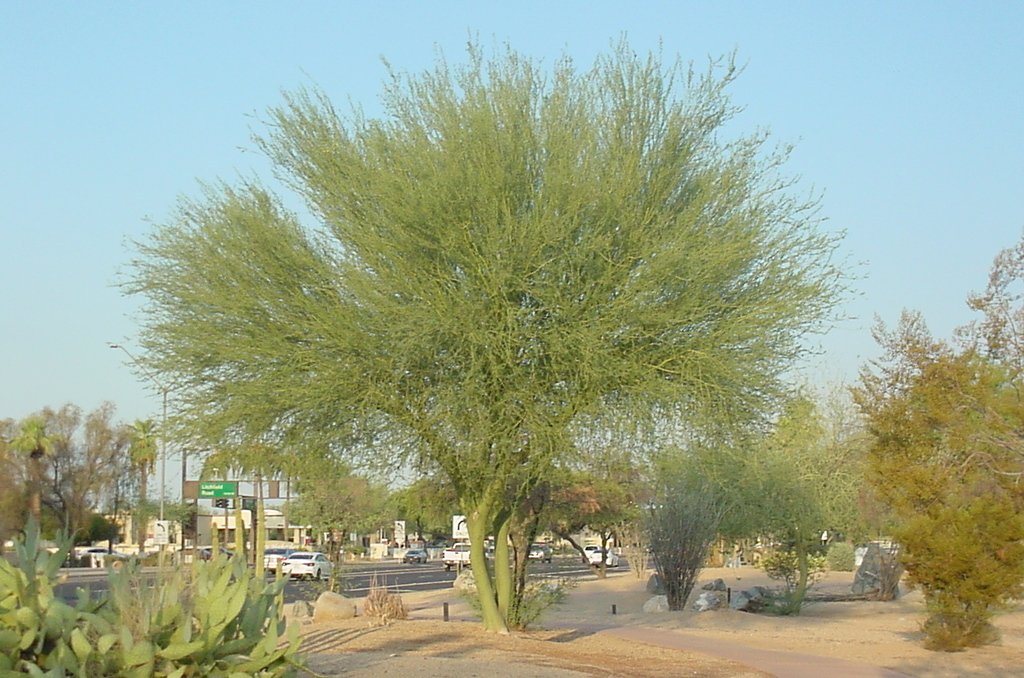Palo Brea
Parkinsonia praecox
Family: Fabaceae
CHARACTERISTICS
Medium sized, thorny tree, usually reaching about 25’ h&w. Leaves are drought or cold deciduous. This species has a photosynthesizing green trunk. This is one of the palo verde species that retains its green trunk, while trees like the blue palo verde will lose the green trunk with age. This species blooms in the late spring with masses of yellow flowers followed by pods.
NOTE: plants called Parkinsonia x sonorae are wild hybrids between this species and Parkinsonia microphylla (foothills palo verde)—they have a darker green trunk and don’t get quite as tall.
LANDSCAPE USE
This is a rather attractive, medium sized tree with a sculptural look and striking green trunk. Older trees can provide good shade.
GROWING CONDITIONS
AN EXPLANATION OF TERMS USED
SUN full sun
WATER moderate to low water
SOIL not picky but good drainage encouraged
HARDINESS hardy to about 20-25°F. Be careful—this plant has a wide distribution, and some populations are frost tender. Plants obtained from California have often been found to be more frost tender. Ensure you are getting a locally grown/selected plant.
BASIN high zone
CONTAINER does ok in container but will not attain full size
NUTRITION low
MAINTENANCE very little, prune thorny branches that reach into high traffic areas
Photo by Cuidando al playero rojizo y al pejerrey, iNaturalist
Parkinsonia praecox on SEINET
ECOLOGY
Flowers provide nectar for butterflies and bees, important nesting plant, attractive form with a trunk stays green with age. Palo verdes are the favorite host for the larvae (grub worm) of the palo verde beetle (Derobrachus hovorei). Though they are blamed for the demise of palo verdes, these beetles mostly eat dead wood and these species have evolved together for thousands of years. Desert mistletoe is also hosted on palo verdes and gets blamed for killing them. Usually, the real demise of blue palo verdes is the dropping water table caused by humans. This is a larval host for the Forsebia Moth (Forsebia cinis), Juno Buckmoth (Hemileuca juno), Royal Poinciana Graphic (Melipotis acontioides), and the Black-tipped Rudenia Moth (Rudenia leguminana).
ETHNOBOTANY
The Mayo had many uses for palo brea: there was a limited use as wood for construction and burning. The trunk exudes a light-colored pitch or tar, a waxy coating, which is used as glue and is also used as a remedy for arthritis, diabetes, bronchitis, and asthma, and is eaten as a sweet as well. A tea brewed from the bark is said to be good for bruises, sprains, and strains but supposedly turns urine dark.
NATURAL DISTRIBUTION
Usually below 2500 ft. mostly in northwestern Mexico south to Guatemala, with a disjunct population in Argentina.
TAXONOMY AND NAME
This plant is in the Fabaceae, the legume family. There are 9 species of Parkinsonia.
Parkinsonia was named for the author John Parkinson (1597-1650) an English herbalist/botanist. Praecox means early in latin, probably referring to the flowering time in its native habitat—the “brea” in palo brea also means early.
Formerly known as Cercidium praecox.

This species maintains a very green trunk, even with age. It makes a great urban tree because it grows very erect when young. Blue palo verde, by contrast, grows much wider and can be too wide when young. Photo by dtsmitty, iNaturalist

The flowers are bright yellow and are tight against the stems. Photo by aacocucci, iNaturalist

Seedpods follow the flowers, photo by Mabeli González, iNaturalist
The Sonoran palo verde (Parkinsonia x sonorae) is native to Sonora, Mexico. It is a cross between foothill palo verde (Cercidium microphyllum) and palo brea (Cercidium praecox). Photo by staticvoid11, iNaturalist


